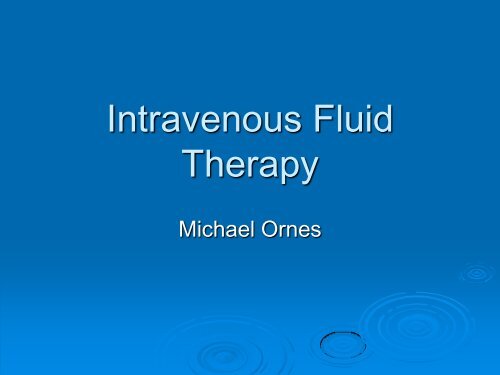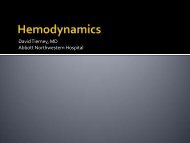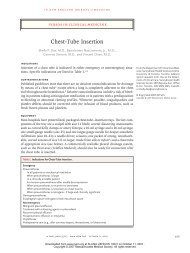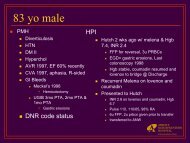Intravenous Fluid Therapy
Intravenous Fluid Therapy
Intravenous Fluid Therapy
Create successful ePaper yourself
Turn your PDF publications into a flip-book with our unique Google optimized e-Paper software.
<strong>Intravenous</strong> <strong>Fluid</strong><br />
<strong>Therapy</strong><br />
Michael Ornes
Why use intravenous fluids?<br />
‣ If the gut works use it!<br />
‣ Think about why you are ordering IVF.<br />
• NPO.<br />
• Significant volume deficit.<br />
• On going losses.<br />
• Specific goal to fluid therapy. (e.g. hydration prior to contrast<br />
dye.)<br />
‣ Consider appropriateness of IVF daily in each patient.<br />
‣ Do not use IVF if they are unnecessary. There are<br />
potential complications:<br />
• <strong>Fluid</strong> overload.<br />
• Dangerous electrolyte derangements.<br />
• Line infections.
Distribution of Total Body Water<br />
‣ Total Body Water (TBW):<br />
• Wt (Kg) x .6 (m) .5 (f) = TBW in liters.<br />
• 70 x .6 = 42 L<br />
‣ Next, consider the different fluid<br />
compartments within the body.<br />
• “2/3,1/3” rule.
<strong>Fluid</strong> Compartments<br />
TBW<br />
Intracellular <strong>Fluid</strong><br />
2/3 of TBW<br />
Extracellular <strong>Fluid</strong><br />
1/3 of TBW<br />
Interstitial <strong>Fluid</strong><br />
2/3 of ECF<br />
Intravascular <strong>Fluid</strong><br />
1/3 of ECF
<strong>Fluid</strong> Compartments<br />
‣ 70 kg male:<br />
• TBW= 42 L<br />
• Intracellular volume = .66 x 42 = 28 L<br />
• Extracellular volume = .34 x 42 = 14 L<br />
• Interstitial volume = .66 x 14 = 9 L<br />
• Intravascular volume = .34 x 14 = 5 L
<strong>Fluid</strong> Compartments<br />
TBW 42 L<br />
Intracellular <strong>Fluid</strong><br />
2/3 of TBW<br />
28 L<br />
Extracellular <strong>Fluid</strong><br />
1/3 of TBW<br />
14 L<br />
Interstitial <strong>Fluid</strong><br />
2/3 of ECF<br />
9 L<br />
Intravascular <strong>Fluid</strong><br />
1/3 of ECF<br />
5 L
<strong>Fluid</strong> Requirements<br />
‣ Normal adult requires approximately 35cc/kg/d.<br />
• IBW = 50 (m) 45.5 (f) + (2.3 per in. > 5 ft.)<br />
‣ This assumes normal fluid loss.<br />
• Urine<br />
• Stool<br />
• Insensible<br />
‣ Watch I/O carefully and be aware of other<br />
losses.<br />
• Fever increases insensible loss by 200cc/day for<br />
each degree (C).<br />
• Monitor abnormal GI loss e.g. NGT suctioning.
<strong>Fluid</strong> Requirements<br />
‣ “4,2,1” Rule<br />
• First 10 kg= 4cc/kg/hr<br />
• Second 10 kg= 2cc/kg/hr<br />
• 1cc/kg/hr thereafter<br />
‣ In adults remember IVF rate = wt (kg) + 40.<br />
• 70 + 40 = 110cc/hr<br />
• Assumes no significant renal or cardiac disease and NPO.<br />
‣ This is the maintenance IVF rate, it must be adjusted for<br />
any dehydration or ongoing fluid loss.<br />
‣ Conversely, if the pt is taking some PO, the IVF rate<br />
must be decreased accordingly.<br />
‣ Daily lytes, BUN ,Cr, I/O, and if possible, weight should<br />
be monitored in patients receiving significant IVF.
Electrolyte Requirements<br />
‣ Na: 1-3 meq/kg/day<br />
‣ 70 kg male requires 70-210 meq NaCl,<br />
2600 cc fluid per day.<br />
‣ 0.45% saline contains 77 meq NaCl per<br />
liter.<br />
• 2.6 x 77 = 200 meq<br />
‣ Thus, 0.45% saline is usually used as<br />
MIVF assuming no other volume or<br />
electrolyte issues.
Electrolyte Requirements<br />
‣ Potassium: 1 meq/kg/day<br />
‣ K can be added to IV fluids. Remember this<br />
increases osm load.<br />
‣ 20 meq/L is a common IVF additive.<br />
• This will supply basal needs in most pts who are<br />
NPO.<br />
‣ If significantly hypokalemic, order separate K<br />
supplementation.<br />
• Oral potassium supplementation is always preferred<br />
when feasible.
<strong>Intravenous</strong> <strong>Fluid</strong>s<br />
‣ 0.9 % Saline<br />
• Na: 154 Cl: 154 Osm: 308<br />
‣ 0.45 % Saline<br />
• Na: 77 Cl: 77 Osm: 154<br />
‣ LR<br />
• Na: 130 Cl: 109 Lactate: 28 K: 4 Ca: 3 Osm:273<br />
‣ D5<br />
• Adds 50 gm glucose per liter, 170 kcal, 250 Osm<br />
‣ 3 % Saline<br />
• Na: 512 Cl: 512 Osm: 1024
Which fluid to Choose?<br />
‣ 1: What is your goal for therapy?<br />
• Maintenance<br />
• Rehydration<br />
• Volume resuscitation<br />
‣ 2: Any baseline electrolyte abnormalities?<br />
• ALWAYS look at basic chemistry prior to<br />
ordering fluids.<br />
‣ 3: Where is the fluid going to go?
Which <strong>Fluid</strong> to Choose?<br />
‣ Hypovolemia: primary goal is volume<br />
expansion.<br />
• Use the fluid that will put the most volume into<br />
the intravascular space. NS or LR.<br />
‣ Dehydration (= hyperosmolality): primary<br />
goal is free water replacement. Note that<br />
this is not synonymous with hypovolemia.<br />
• Use a hypotonic fluid usually 0.45% saline or<br />
D5W.
Which <strong>Fluid</strong> to Choose?<br />
‣ Post-operative patients:<br />
• Pain and narcotics can be powerful stimulants<br />
of inappropriate ADH secretion (SIADH)<br />
• Giving hypotonic fluids in this setting can (but<br />
usually does not) cause dangerous<br />
hyponatremia.<br />
• This makes 0.9 % saline a safer fluid but<br />
realize that it will also deliver free water in the<br />
setting of SIADH. (stay tuned for a future<br />
lecture)
Why NS for volume expansion?<br />
‣ How much volume expansion per liter of<br />
fluid.<br />
‣ Concepts:<br />
• Free water is distributed evenly throughout<br />
the TBW “compartment”<br />
• Essentially 100% of sodium if confined to the<br />
extracellular space<br />
• Normal saline contains essentially no free<br />
water.
Remember where the fluids you<br />
are ordering are going<br />
TBW<br />
Intracellular <strong>Fluid</strong><br />
2/3 of TBW<br />
Extracellular <strong>Fluid</strong><br />
1/3 of TBW<br />
Interstitial <strong>Fluid</strong><br />
2/3 of ECF<br />
Intravascular <strong>Fluid</strong><br />
1/3 of ECF
‣ 1000cc D5W:<br />
• 2/3 to intracellular space = 660cc<br />
• 1/3 to extracellular space = 330cc<br />
• 2/3 to interstitial space = 220cc<br />
• 1/3 to intravascular space = 110cc<br />
• 110/1000 = 11 %
‣ 1000 cc 0.45% saline<br />
• 500 cc free water throughout TBW<br />
• 55 cc intravascular space<br />
• 500 cc to ECV<br />
• 2/3 to interstitial space = 330 cc<br />
• 1/3 to intravascular space = 170 cc<br />
• 225 cc into the intravascular space
‣ 1000 cc 0.9% saline:<br />
• Essentially all confined to extracellular<br />
compartment<br />
• 2/3 to interstitial space = 660 cc<br />
• 1/3 to intravascular space = 340 cc<br />
• Approximately 33 %
Examples<br />
‣ 35 y/o female NPO for elective lap chole.<br />
Afebrile HR 72 BP 120/80 Wt 85 kg. Na<br />
140 K 4.0. <strong>Fluid</strong> Orders:<br />
• D5 0.45% saline with 20meq KCl @ 125<br />
cc/hr.
Examples<br />
‣ 40 y/o with idiopathic cardiomyopathy. EF<br />
= 15%. Crackles ½ up both lung fields to<br />
auscultation and 3+ edema of both lower<br />
extremities, JVP elevated. Na: 130, K: 5.1,<br />
Cr: 2.3. IVF?<br />
‣ This pt is both water (hyponatremia) and<br />
salt (edema) overloaded and will require<br />
diuresis.<br />
‣ Heparin lock.
Examples<br />
‣ 55 y/o male. In ED for fever and rigors.<br />
T 39.0, HR 120, BP 70/40 RR 35 WBC:<br />
25,000; UA: 500 WBC/hpf, many bacteria.<br />
<strong>Fluid</strong> orders:<br />
• 0.9% saline wide open.<br />
• This means a bag of saline in a pressure<br />
device through a large bore iv, probably two in<br />
this case.<br />
• Reassess for clinical response.
Examples<br />
‣ 89 y/o nursing home pt. admitted for<br />
diverticulitis. T 38.0 HR 90 BP 145/85. wt<br />
70 kg Na: 140, K: 3.7. Not eating. <strong>Fluid</strong><br />
Orders:<br />
• Basal needs 70 + 40 = 110cc/hr<br />
• Additional loss from fever = approx. 10 cc/hr<br />
• Total rate = 120 cc/hr: IVF?<br />
• (D5) 0.45% saline with 20 meq KCl
Examples<br />
‣ 50 y/o with massive hematemisis, SBP 80<br />
HR 130 IVF?<br />
‣ 0.9% saline WIDE OPEN through two<br />
large bore IVs.<br />
‣ O neg STAT<br />
‣ Type and cross 6 units PRBC STAT.
Examples<br />
‣ 65 y/o male hospitalized with pneumonia.<br />
Temp 38.5, HR 72, BP 125/72. Wt 75 kg.<br />
Na:165 K: 4.0. Orders:<br />
• Basal needs 115 cc/hr + 12 cc/hr for fever.<br />
Also:<br />
• Free water deficit of (.6)(75)[(165/140) – 1] =<br />
7.6 liters.<br />
• IV # 1: 0.45% saline @ 130 cc/hr.<br />
• IV # 2: D5W @ 150cc/hr for 50 hrs.
Examples<br />
‣ 30 y/o male admitted for ITP. Platelets 6,<br />
T 37.0, HR 72, BP 120/80, Wt 80 kg. Eating<br />
well. IVF orders:
Remember……..<br />
‣ Your fluid orders are incomplete until you<br />
have ordered monitoring labs (lytes, Cr,<br />
etc), I/O, daily weights.<br />
‣ IVF orders are often more art than<br />
science.<br />
• There may be several reasonable rates to<br />
order– be sure that you have thought your<br />
orders out.<br />
• The basic fluid, i.e. isotonic, hypotonic,<br />
hypertonic, should be clear.






